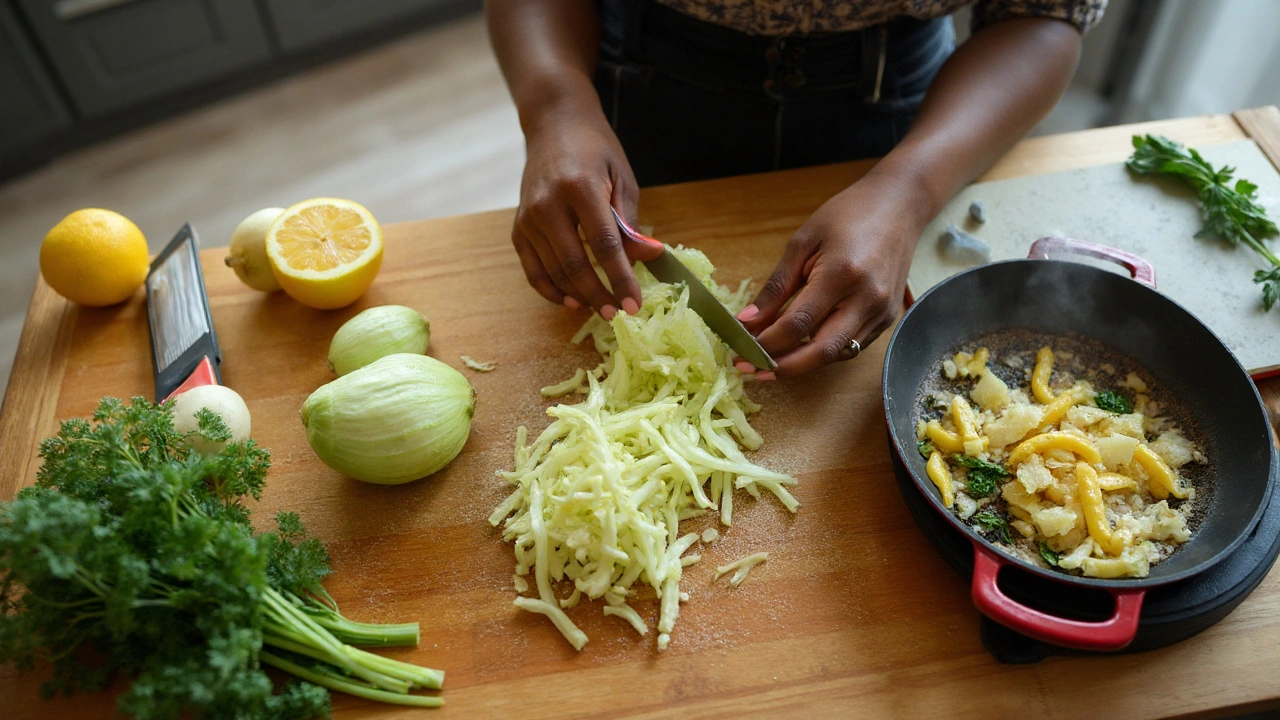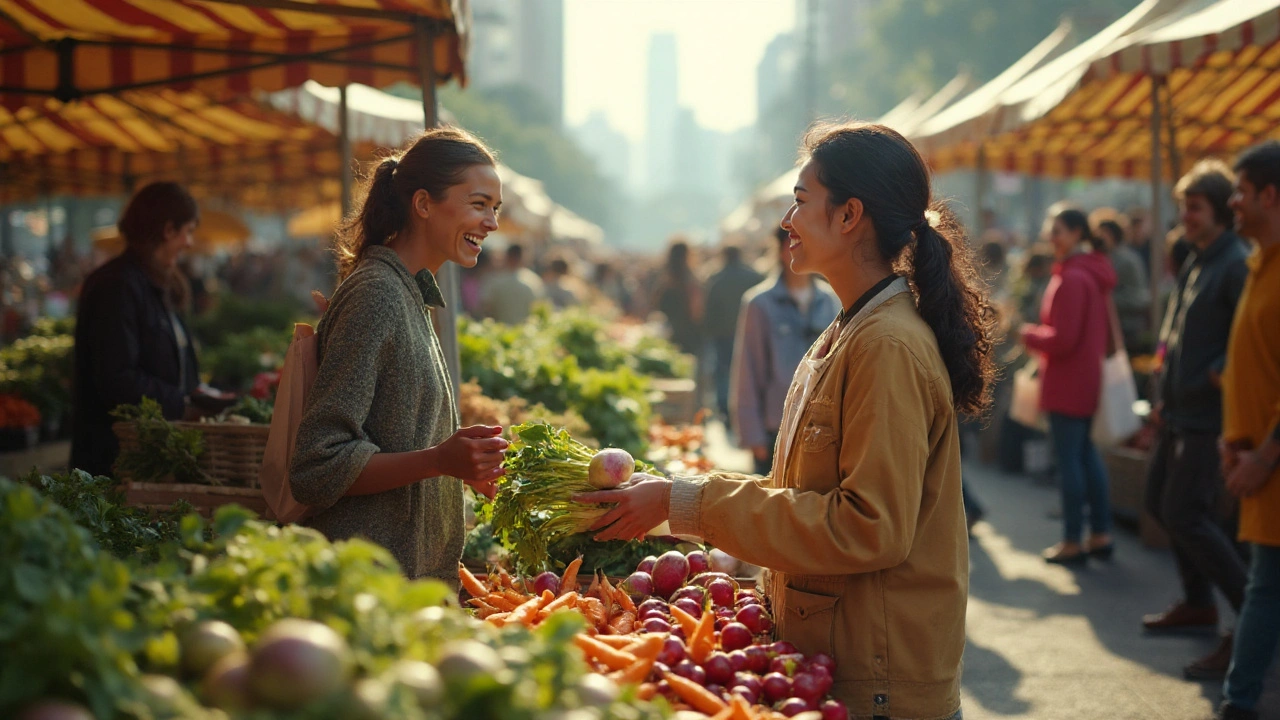TL;DR
- Kohlrabi is a crunchy, mildly sweet brassica that’s easy to prep raw or cooked-think apple-meets-broccoli stem.
- Per 100g: ~27 kcal, ~3.6g fibre, ~60mg vitamin C-handy for immunity, gut health, and low-cal eating (USDA, 2024).
- Buy small, heavy bulbs; peel thickly; use leaves like kale. Raw for slaw, roasted for chips, sautéed for quick sides.
- Great for weight loss, low-carb, and diabetes-friendly plates thanks to low calories and low glycaemic load.
- Season in the UK: late spring to autumn; expect £1.20-£2.00 per bulb at supermarkets or markets in 2025.
You’ve likely walked past kohlrabi and thought, “What on earth do I do with that?” Here’s the simple truth: it’s affordable, versatile, and ridiculously forgiving. If you can chop an apple and roast a potato, you can master kohlrabi today. No chef tricks, no expensive kit-just quick wins for taste and health.
What kohlrabi is, why it’s worth eating, and how it stacks up nutritionally
Kohlrabi is a bulbous cousin of cabbage and broccoli. The “bulb” is actually a swollen stem. It looks alien, but it tastes familiar-crisp like an apple, with a gentle brassica vibe. The skin can be pale green or purple; the flesh is always white. You can eat the bulb raw or cooked, and the leaves behave like kale or collard greens.
Why the fuss? It’s the kind of food that checks several boxes at once: low calorie, high fibre, concentrated vitamin C, useful potassium, and pleasing crunch. If your meals need more veg without more effort, kohlrabi slots right in.
Key benefits (plain English):
- High vitamin C supports immune function and iron absorption. One cup (about 135g) can get you close to or over half your daily needs.
- Fibre feeds gut bacteria and helps you feel full, which can help with weight management. The NHS suggests around 30g fibre per day; kohlrabi gives you a tidy bump without many calories.
- Low energy density: it fills the plate for very few calories-great for volume eaters.
- Low glycaemic load: kinder on blood sugar compared to starchy sides.
- Cruciferous family perks: contains glucosinolates (sulphur compounds) that scientists study for their role in normal cell processes and detox pathways. You’re not eating a miracle pill-but it’s a solid, evidence-backed veg choice.
How it compares per 100g (typical raw values):
| Food (raw, 100g) | Calories (kcal) | Carbs (g) | Fibre (g) | Protein (g) | Vitamin C (mg) | Potassium (mg) | Notable |
|---|---|---|---|---|---|---|---|
| Kohlrabi | ~27 | ~6.2 | ~3.6 | ~1.7 | ~60 | ~350 | Low cal, crisp texture |
| Broccoli | ~34 | ~6.6 | ~2.6 | ~2.8 | ~89 | ~316 | Higher vitamin C |
| Apple | ~52 | ~14 | ~2.4 | ~0.3 | ~4.6 | ~107 | More sugar |
Sources: USDA FoodData Central (2024). For daily reference values: European Food Safety Authority (vitamin C 80mg/day, potassium 3500mg/day). For fibre targets: NHS Eatwell guidance (around 30g/day).
What does this mean for you? If you’re trying to keep calories low without eating like a bird, kohlrabi helps. If you’re watching blood sugar, the net carbs are modest (roughly 2.5-3g per 100g once you subtract fibre). If you’re just bored of lettuce, it gives you crunch and bite in minutes.
Is it truly a “superfood”? The word gets abused. But if you define “super” as nutrient-dense, versatile, and easy to eat often, kohlrabi earns the label. Eat it because it’s practical, not mystical. That’s the kind of habit that sticks.
Quick UK buying note (2025): I pick it up in Birmingham at supermarkets or the Saturday market. Typical price is £1.20-£2.00 per bulb, cheaper in season (late spring to autumn). Look for compact, heavy bulbs with perky leaves. Avoid soft spots and cracks.

Your kohlrabi playbook: buying, prepping, cooking, and eating it tonight
If your main worry is “I’ll buy it and it’ll rot,” this section wipes that out. Here’s the simple, repeatable flow from shop to plate.
Buy smart (30-second checklist):
- Size: pick small-to-medium bulbs (6-8cm across) for tender, sweet flesh. Larger bulbs can be woody but are fine for roasting and soups.
- Weight: heavy for size = juicy. Light = drying out.
- Skin: smooth, no deep cracks. A few scuffs are fine.
- Leaves: bright and firm. Limp leaves mean it’s been hanging around.
Store it right:
- Separate leaves from bulbs when you get home. Leaves go into a bag with a paper towel; use within 3-4 days.
- Bulbs keep in the veg drawer 1-2 weeks. Don’t wash until you’re ready to use.
Prep (the only “trick”):
- Trim leaves and stems. Save leaves.
- Cut off top and base to create flat sides.
- Stand it up; peel thickly with a knife or sturdy peeler. Remove all fibrous outer layer until only white flesh remains.
- Slice, dice, matchstick, or grate depending on the recipe.
Decision guide: what to cook based on bulb size and time
- Small bulb, minimal time (5-10 min): eat raw-slaw, sticks with hummus, quick salad.
- Medium bulb, weeknight (15-25 min): sauté, stir-fry, or air-fry chips.
- Large bulb, batch-cooking (25-40 min): roast cubes, mash, soup, or gratin.
- Leaves anytime (5-7 min): sauté like kale with garlic and lemon.
Five go-to methods (no fuss):
- Raw slaw (5 minutes): Shred kohlrabi and carrot. Toss with Greek yogurt, lemon, Dijon, salt, pepper, a drizzle of honey. Add apple if you like it sweeter.
- Quick sauté (10 minutes): Matchstick kohlrabi. Fry in olive oil with garlic and chilli. Finish with lemon and parsley. Add Parmesan if you want it richer.
- Roasted chips (25 minutes): Cut into wedges. Toss with oil, smoked paprika, salt. Roast at 220°C, shaking once. Crisp outside, tender inside.
- Stir-fry (12 minutes): Thin slices, high heat, sesame oil, ginger, soy or tamari. Add tofu, chicken, or prawns. Finish with spring onion.
- Silky mash (20 minutes): Steam kohlrabi chunks until very soft. Mash with butter or olive oil, salt, pepper, and a spoon of crème fraîche. Great swap for part of your potato.
Quick recipes you can cook after work
- Kohlrabi-apple salad: Thinly slice kohlrabi and apple. Lemon, olive oil, salt, black pepper, toasted almonds. Fresh, crunchy, done in 6 minutes.
- Cheesy kohlrabi bake: Layer thin slices in a small dish with a splash of cream, garlic, thyme, and a light scatter of cheddar. Bake until bubbling and tender.
- Ten-minute taco topper: Grate kohlrabi, toss with lime, coriander, and a pinch of salt. Pile on fish or bean tacos for crunch.
- Speedy pickles: Matchsticks in a jar with vinegar, water, sugar, salt, garlic, chilli. Chill 30 minutes. Great on sandwiches and rice bowls.
- Air-fryer fries: Sticks, oil, salt, paprika. 200°C for 12-15 minutes, shaking once. Serve with yoghurt-garlic dip.
Use the leaves (don’t bin them): Treat them like kale-wash well, strip tough ribs, and sauté in olive oil with garlic. Finish with lemon and flaky salt. They also work in smoothies and soups for extra greens.
Seasoning pairs that never fail: lemon, lime, apple, carrot, dill, parsley, mint, cumin, coriander, smoked paprika, garlic, ginger, sesame, soy/tamari, Parmesan, cheddar, tahini, yoghurt. If you’re unsure, pick one acid (lemon), one herb (parsley), and one nutty note (olive oil or sesame) and you’re golden.
Portion sizes and macros (rule of thumb):
- Raw snack: 100-150g (about 1 cup sliced) for 25-40 kcal.
- Side dish: 150-200g per person.
- Main in veg-heavy bowls: 250-300g plus protein and fats to balance.
Diet-specific quick notes:
- Weight loss: low energy density helps you eat big portions for fewer calories.
- Low-carb/keto: net carbs are low (roughly 2.5-3g per 100g), so it’s an easy veggie to work in.
- Diabetes-friendly: use it to replace some or all potatoes/pasta in sides. Check your personal response if you monitor glucose.
- Gluten-free: naturally GF. Watch sauces (soy, dressings) for hidden gluten.
- Low-FODMAP: small portions are often tolerated, but bigger servings may cause gas in sensitive folks-test for yourself and keep portions modest at first.
Food safety and quirks: Raw crucifers can cause bloating for some. Start with half a cup and build up. If you have thyroid concerns, cooking reduces goitrogenic compounds; keep variety in your veg and you’ll be fine. Rinse well to remove soil trapped near the stems.
Cost-savvy tip (UK 2025): Buy multi-bulb packs for savings. If bulbs are huge, split with a friend or prep and freeze par-cooked cubes for soups and stews.
A quick weekly plan to make it stick:
- Monday: Raw slaw next to grilled chicken or halloumi.
- Wednesday: Stir-fry with tofu, ginger, and greens.
- Friday: Air-fryer chips with fish or a veggie burger.
- Sunday batch: Roast cubes to throw into salads and omelettes all week.

Cheat sheets, comparisons, and your questions answered
This is the grab-and-go section. Bookmark it, screenshot it, or stick it on the fridge.
Quick cheat sheet
- Best first recipe: raw kohlrabi-apple slaw (no cooking, 5 minutes).
- Best “wow” moment: air-fryer chips-most people don’t see it coming.
- Best meal-prep: roasted cubes-keep 4 days in the fridge.
- Best nutrition booster: sauté the leaves with lemon; they’re a free side dish.
- Best swap: half potatoes, half kohlrabi in mash to cut calories and add fibre.
Flavor pairing matrix (fast choices):
- Bright and fresh: lemon + dill + yoghurt
- Warming: cumin + coriander + garlic + olive oil
- Asian-leaning: ginger + garlic + soy/tamari + sesame
- Comforting: butter + thyme + cheddar
What kohlrabi beats, equals, or complements
- Beats cucumbers for fibre and vitamin C when you want crunch in salads.
- Equals broccoli’s versatility but with a milder taste if you’re feeding picky eaters.
- Complements potatoes: mix in roasts and mashes to lighten the carb load without losing satisfaction.
Scenarios & trade-offs
- Need speed vs. texture: raw is fastest, roasted tastes best; sauté is your compromise.
- Feeding kids: thin slices, mild dip, and a dash of lemon. Skip too much chilli first time.
- Low-carb goal: go roasted or sautéed; avoid heavy breadcrumb coatings.
- Meal-prep warriors: roast on a big tray; slaws don’t hold as well once dressed-store dressing separately.
Mini-FAQ
- Do I have to peel it? Yes. The outer layer is tough. Peel until only tender white flesh remains.
- Can I eat it raw? Absolutely. It’s crisp and sweet-great with dips or in slaws.
- Are the leaves edible? Yes. Treat like kale-sauté, steam, or add to soups.
- Is it good for diabetics? It’s low calorie and low glycaemic load. Pair with protein and healthy fats for steadier blood sugar.
- Any anti-nutrient worries? Like other brassicas, raw kohlrabi has goitrogens; cooking reduces them. Diverse veg intake is the real win.
- How long will it last? Bulbs: up to 2 weeks in the fridge. Leaves: 3-4 days.
- What does it taste like? Imagine a broccoli stem crossed with a crisp apple, without the sweetness.
- Which is better, green or purple? Same taste. Purple skins look pretty; flesh is the same.
- Where to buy in the UK? Major supermarkets, farmers’ markets, and veg boxes carry it more often in season (late spring to autumn).
Evidence notes in plain language: Data for calories, fibre, vitamin C, and potassium come from USDA FoodData Central (2024). UK fibre targets are from the NHS Eatwell guide. European daily reference values for vitamin C (80mg) and potassium (3500mg) come from EFSA. Research on cruciferous veg focuses on glucosinolate compounds and general diet patterns; no single veg prevents disease. Eat kohlrabi as part of a varied diet.
Pro tips to skip rookie mistakes
- Peel more than you think. If it’s stringy, you didn’t go deep enough.
- Salt early for raw salads to draw water, then drain or pat dry before dressing-no watery slaw.
- Roast hot (220°C) and don’t overcrowd the tray for crisp edges.
- Acid at the end (lemon/lime) brightens flavour and balances any brassica notes.
- Use a mandoline for paper-thin slices if you want a restaurant-style salad.
One-sentence promise you can trust: If you peel it well and keep heat high for roasts, you’ll get sweet, tender kohlrabi without fuss.
Health-first reminder: Don’t expect magic. Expect a steady, tasty way to eat more plants without feeling deprived. That’s the move that lasts.
Now for the pièce de résistance-why many readers come here in the first place: practical recipes and a simple plan to make kohlrabi a weekly staple.
Five fast, flavour-packed recipes (full steps)
- 5-minute lemon-dill slaw
- Grate 1 small kohlrabi and 1 carrot.
- Whisk 3 tbsp Greek yogurt, 1 tbsp lemon juice, 1 tsp Dijon, salt, pepper, tiny drizzle of honey.
- Toss, rest 2 minutes, add dill. Eat right away or chill up to 2 days.
- Ginger-garlic stir-fry (serves 2)
- Slice 1 medium kohlrabi thin; chop a handful of leaves.
- Heat 1 tbsp sesame oil; add 1 tsp grated ginger and 1 minced garlic clove; 30 seconds.
- Add kohlrabi, stir 4-5 minutes; splash with 1 tbsp soy/tamari; toss in leaves to wilt.
- Finish with sesame seeds and spring onion.
- Smoky roast with tahini drizzle
- Cube 2 bulbs; toss with 1.5 tbsp olive oil, 1 tsp smoked paprika, salt.
- Roast at 220°C for 25 minutes, shaking once.
- Mix 2 tbsp tahini, 1 tbsp lemon, warm water to thin, pinch of cumin; drizzle over.
- Half-and-half mash
- Steam 300g kohlrabi and 300g potato until very soft.
- Mash with 1 tbsp butter, splash of milk, salt, pepper, chives if you’ve got them.
- 10-minute taco topper
- Matchstick 1 small kohlrabi; toss with juice of 1 lime, pinch of salt, chopped coriander.
- Add to fish or bean tacos for crunch and freshness.
Nutrition-focused swaps
- Swap half your chips for roasted kohlrabi wedges to halve calories per bite without losing crunch.
- Use kohlrabi “noodles” (spiralized) for a low-carb pad thai with prawns or tofu.
- Stir grated kohlrabi into mince (beef/turkey/plant) for juicy burgers with less fat.
Why this works in real kitchens: It’s quick, it’s flexible, and it doesn’t dominate the plate. If you’re cooking for fussy eaters, kohlrabi blends into familiar dishes with a clean crunch and mild taste. That’s the stealth veggie advantage.
And the one phrase to keep your search intent satisfied: kohlrabi benefits are real, practical, and easy to unlock with 10 minutes and a peeler.
Notes from the ground (Birmingham, 2025): I’m seeing more UK-grown kohlrabi in summer veg boxes and at markets. Supermarkets stock it more often now-sometimes near the cabbages, sometimes with “speciality veg.” Don’t be shy about asking staff where it’s hiding.
Next steps
- Buy two bulbs this week: one for raw (slaw/salad), one for roast or stir-fry.
- Cook once, eat twice: roast extra and keep in the fridge for bowls and omelettes.
- Use the leaves the same night you shop so they don’t wilt in the drawer.
Troubleshooting
- It tastes bitter: it might be old or under-peeled. Peel deeper; add lemon and a pinch of salt.
- Slaw turned watery: salt the shreds and let them sit 5 minutes, then squeeze out moisture before dressing.
- Roast stayed soft: raise heat to 220°C, don’t overcrowd the tray, and preheat properly.
- Texture is stringy: stick to smaller bulbs next time or use large ones for soups and mashes.
- Stomach feels gassy: start with smaller portions, cook it instead of eating raw, and add new crucifers gradually.
Who should make this their go-to veg?
- Busy parents: five-minute slaw and 20-minute roasts save the evening.
- Gym-goers: low-cal volume plus potassium and vitamin C makes it a smart side.
- People watching blood sugar: swap part of potatoes with kohlrabi in mashes and roasts.
- Budget-focused shoppers: seasonal bulbs stretch meals without stretching wallets.
Bottom line for action: pick up a couple of bulbs on your next shop. Peel deep, try a raw salad tonight, roast the rest for tomorrow. By this time next week, kohlrabi will feel like an old friend.






10 Comments
Nondumiso Sotsaka
September 5, 2025 AT 18:50 PMGreat to see you giving kohlrabi a try 😊 It’s a versatile veg that fits right into busy schedules and still packs a nutrition punch 🥦 Peel it deep, slice thin, and you’ll have a crunchy base for salads or a sweet side when roasted. Remember to give the leaves a quick sauté – they’re a hidden source of fibre and vitamin C. Keep experimenting and you’ll discover new flavours each week!
Ashley Allen
September 6, 2025 AT 05:57 AMIt’s a solid low‑calorie addition for meal prep.
Brufsky Oxford
September 6, 2025 AT 17:04 PMWhen we consider food as a gateway to mindful living, kohlrabi becomes a quiet teacher 🍃 Its crisp texture invites us to slow down, notice the subtle sweetness, and reflect on the simplicity of nourishment. The act of peeling away its outer layer mirrors the philosophical stripping of pretense, revealing the pure essence within. In that sense, every bite is a small meditation on presence. Embrace the experience and let the vegetable speak to your senses 😊
Lisa Friedman
September 7, 2025 AT 04:10 AMDid you knwo that kohlrabi actually contains about 60mg of vitamin C per 100g, which is close to half the daily recommendtion? It’s also low in caloriess, only around 27kcal, making it perfect for weight loss diets. The fibre content helps regulat blood sugar and supports gut bacteria. So, if you’re looking for a superfood that won’t break the bank, this is it.
cris wasala
September 7, 2025 AT 15:17 PMHey there love the idea of adding kohlrabi to your meals it’s super easy to prep and it brings a nice crunch to any dish keep it in the fridge and you’ll have a ready‑to‑go veggie for weeks happy cooking
Tyler Johnson
September 8, 2025 AT 02:24 AMKohlrabi is one of those understated vegetables that often gets overlooked in the supermarket aisle, yet it holds a remarkable blend of nutritional benefits and culinary flexibility. Its low calorie count means you can fill a plate without worrying about excess energy intake, which is a boon for anyone watching their weight. The high fibre content not only aids digestion but also promotes a feeling of fullness that can help curb unnecessary snacking between meals. Vitamin C levels are impressive, supporting immune function and enhancing iron absorption from other foods on your plate. Potassium present in kohlrabi assists in maintaining healthy blood pressure, a subtle yet important cardiovascular benefit. For those managing blood sugar, the low glycaemic load makes it a smart swap for starchy sides such as potatoes or rice. The crisp texture remains satisfying whether you eat it raw in a slaw or lightly sautéed for a quick side. Roasting brings out a natural sweetness that can rival many root vegetables while keeping the carb count modest. The leaves, often discarded, are nutritionally comparable to kale and can be tossed into soups or stir‑fries for an extra green boost. From a practical standpoint, kohlrabi stores well in the fridge for up to two weeks, giving you flexibility in meal planning. Its mild flavor makes it an excellent canvas for a wide range of seasonings, from smoky paprika to bright lemon and dill. Budget‑wise, a couple of bulbs can stretch across several meals, especially when you batch‑cook and freeze portions for later use. In terms of culinary creativity, you can spiralize it into noodles for a low‑carb pasta alternative or grate it into burgers for added moisture without extra fat. The vegetable also pairs nicely with proteins like chicken, fish, or tofu, creating balanced dishes that satisfy both taste and nutrition goals. Ultimately, incorporating kohlrabi into your weekly routine is a low‑effort, high‑reward strategy that supports health, variety, and convenience in the kitchen.
Annie Thompson
September 8, 2025 AT 13:30 PMI can’t help but feel a pang of melancholy every time I slice into a kohlrabi and see that pale flesh like a hidden secret waiting to be uncovered it’s as if the vegetable is pleading for attention amidst a sea of flashier greens its quiet presence demands a listener who will hear its subtle crunch and sweet‑sour whisper it’s not just another side dish it’s a story of resilience growing in the cool earth waiting for the right hands to peel away its layers and reveal the tender core inside the kitchen becomes a stage where kohlrabi performs its understated solo reminding us that nutrition can be poetic and that even the most unassuming veg can carry the weight of tradition and innovation alike the aroma of roasted wedges fills the air like a nostalgic reminder of childhood gardens while the fresh slaw sings a bright tangy chorus that lifts the spirit and the leaves often ignored whisper their own verses of earthy depth and vitamin richness you can’t ignore them forever they will rise again in soups and stews offering comfort on cold evenings and hope in the midst of a hectic day so next time you pass by that humble bulb remember it’s more than just a vegetable it’s a quiet hero waiting to be celebrated
Parth Gohil
September 9, 2025 AT 00:37 AMFrom a culinary workflow perspective, kohlrabi serves as a high‑throughput substrate with a low glycemic index, making it ideal for macro‑balanced meal architectures. Its cell wall composition yields a crisp shear force, which translates to a satisfying bite profile in raw applications, while thermal denaturation during roasting unlocks Maillard‑derived flavor compounds. Pairing it with lipid emulsions like olive oil enhances oleic acid absorption and improves overall satiety metrics. In practice, a 150‑gram serving can contribute roughly 3.6 g of insoluble fibre, supporting gut microbiome diversity and regularity. For athletes tracking micronutrients, the 60 mg of vitamin C per 100 g supports collagen synthesis and oxidative stress mitigation. Overall, integrating kohlrabi into your plate can optimize nutrient density without sacrificing culinary appeal.
VAISHAKH Chandran
September 9, 2025 AT 11:44 AMOnly the discerning palate appreciates the subtle aristocracy of kohlrabi its refinement surpasses the pedestrian carrots and peas of the masses this veg embodies a heritage that our own culinary empire should champion
Pat Merrill
September 9, 2025 AT 22:50 PMOh wow, you’ve cracked the secret to the universe with a purple‑ish stem-who knew dinner could be an existential crisis? Guess we’ll all start meditating over our sauté pans now.